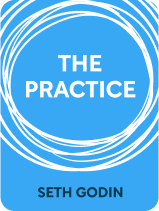

This article is an excerpt from the Shortform book guide to "The Practice" by Seth Godin. Shortform has the world's best summaries and analyses of books you should be reading.
Like this article? Sign up for a free trial here.
Why should you stop seeking reassurance? Do you need confidence to be creative?
In The Practice, Seth Godin asserts that you don’t need confidence to be creative. In fact, you should stop seeking reassurance because it only slows the creative process.
Continue reading to learn why confidence and reassurance aren’t important for creative projects.
Trusting Yourself Doesn’t Mean You Have to Be Confident
Godin contends that you don’t need confidence to do creative work. Confidence is a feeling, and feelings come and go. If you have a practice of doing creative work regularly, you don’t need to depend on whether you feel confident about the work—you just do it.
Confidence doesn’t guarantee a successful outcome in any event. Every game has confident players who don’t win. In fact, insecurity is normal and means you’re trusting the process. If you didn’t have some doubt, you could veer into overconfidence or arrogance, which can lead to inadequate preparation and even illegal behavior such as fraud.
Reassurance Won’t Help You
Trusting yourself also means you need to stop seeking reassurance. Seeking reassurance is not helpful because when you’re in the midst of creative work, you don’t know how it will turn out. For example, if an established writer tells you that a paragraph you wrote is brilliant, that doesn’t mean your whole book will be brilliant. The rest of the book may not meet the same standard. Conversely, if they tell you your paragraph is awful, that doesn’t mean anything about the eventual quality of your entire book.
Godin says that reassurance can’t make up for simply doing the work. Reassurance is for people who crave certainty. Successful artists recognize that certainty and attachment to the outcome are inimical to creating art.
One way to stop seeking reassurance is to focus on generosity: serving others. This way, you are working toward positive change rather than thinking about yourself and your ego. For example, if you are making a painting in the hopes of challenging entrenched, toxic ideologies (such as racism or sexism), you’re trying to effect positive change, not just focusing on yourself.
Fear, Uncertainty, and Creativity
Artists and writers have long acknowledged the relationship between fear, uncertainty, and creativity. Best-selling author Elizabeth Gilbert explains in Big Magic that fear almost always accompanies creativity because the purpose of fear is to protect us from uncertainty—and the creative process is full of uncertainty. Godin evidences a similar take in his advice not to focus on the outcome of creative work because the outcome is always unpredictable and uncertain. Indeed, fear and uncertainty are why artists crave reassurance, he says, but they’re also the very reasons reassurance is futile. There’s no way to inject certainty into an inherently uncertain process.
Gilbert acknowledges that she constantly feels fear with respect to her creative work, but she has learned to embrace it and work with it. She does this in a somewhat unconventional way: Before embarking on a creative project, she has a “conversation” with her fear, in which she tells it that she and creativity are going on a road trip and that, while fear is welcome to come along for the ride, Gilbert and her creativity will be the only ones driving the car.
For Gilbert, creativity doesn’t require fearlessness, but it does require bravery—being scared but doing it anyway. In this sense, her ideas overlap with Godin’s belief that imposter syndrome is normal when you’re doing creative work, and it simply means you’re trusting the process.
Gilbert, Godin, and Steven Pressfield all agree that fear is to be expected when you’re involved in creative pursuits. In fact, Pressfield goes a step further and says fear is actually pointing you toward your passion. In his book, The War of Art, Pressfield argues that you actually feel the most fear and self-doubt (which he terms “resistance”) when you get closer to your true calling. Resistance is like a compass needle that always points you to your most important work.

———End of Preview———
Like what you just read? Read the rest of the world's best book summary and analysis of Seth Godin's "The Practice" at Shortform.
Here's what you'll find in our full The Practice summary:
- Why creativity doesn't require any “magic”
- How creativity is a skill that anybody can learn
- Step-by-step lessons on how to be creative






